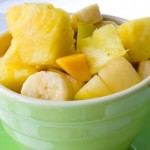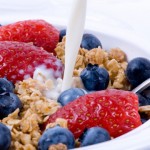Podcast 42: Will Immunity-Boosting Foods, Supplements and Super-dosing prevent COVID-19?
As we move through the rollercoaster ride of what’s been the last year and take
Fibre is a component of carbohydrate, but it is non-digestible. Why then is there such an importance to include it in our diet? Although the components of fibre are not digested by our bodies (meaning our cells don’t take up any of its components to use, but rather it is excreted), fibre has proven many positive health benefits over the years including helping to stabilize our blood sugars (slower release of sugar from food to keep us fuller for longer), decreasing the risk of cardiovascular disease and stroke, obesity, diabetes and certain types of cancer, as well as lowering cholesterol levels. (CVD Practice Guidelines, 2009). Not all fibre is created equally though, and knowing the different types of fibre and where they are found in our food supply will help you better understand why we need to include a variety of different foods to help us meet our daily intake.
Most Canadians do not take in the recommended daily amounts of fibre. For men (14-50 years of age), this is 38 grams per day, and women in the same age group is 25 grams per day. After 50, the recommended amount for men decreases slightly to 30 grams daily, and 21 grams daily for women.
So, fibre is part of the total carbohydrate component in food, but it is not a component of the total carbohydrate which gets transferred to our  blood and into our muscles. When reading a food label, you will see the total amount of carbohydrate always listed on a food package (unless it is a food source which does not require a label). Under this total carbohydrate, the fibre and sugar component are (most often) listed. The third component of carbohydrate is starch, but this does not have to be on a label. In order to understand the amount of carbohydrate in a food item that DOES digest into sugar (glucose) into our bloodstream, you would subtract the total fibre away from the total carbohydrate. In the example provided, per ½ cup serving of this particular food, there is 28 grams of total carbohydrate, and of that, 6 grams is dietary fibre. The total amount of carbohydrate from this food source that would be digested to fuel our brain, muscles, or go into stores is 22 grams (Total Carbohydrate – Dietary Fibre) = 28 grams – 6 grams = 22 grams. The fibre in this food source would help to prevent constipation, lower cholesterol and help slow down the rate that the sugar moves into the bloodstream.
blood and into our muscles. When reading a food label, you will see the total amount of carbohydrate always listed on a food package (unless it is a food source which does not require a label). Under this total carbohydrate, the fibre and sugar component are (most often) listed. The third component of carbohydrate is starch, but this does not have to be on a label. In order to understand the amount of carbohydrate in a food item that DOES digest into sugar (glucose) into our bloodstream, you would subtract the total fibre away from the total carbohydrate. In the example provided, per ½ cup serving of this particular food, there is 28 grams of total carbohydrate, and of that, 6 grams is dietary fibre. The total amount of carbohydrate from this food source that would be digested to fuel our brain, muscles, or go into stores is 22 grams (Total Carbohydrate – Dietary Fibre) = 28 grams – 6 grams = 22 grams. The fibre in this food source would help to prevent constipation, lower cholesterol and help slow down the rate that the sugar moves into the bloodstream.
Most people are aware of the 2 types of fibre that exist, soluble and insoluble, found in the different foods we eat. Soluble fibre has been shown to reduce cholesterol levels and help control blood glucose levels. Soluble fibre in food gives “stickiness” to that particular food, like when you cook oats. Other foods that contain soluble fibre include legumes, barley, oat bran, psyllium, vegetables and certain fruits. Insoluble fibre promotes more of the “bulking” aspect of food, and passes through our digestive tract with little change as to how it is ingested. This type of fibre helps to promote bowel regularity. Insoluble fibre is found in wheat bran, whole grain bread, flax seed and some vegetables and fruit. So, knowing that this type of fibre adds “bulk” to our stool, it is very important that you drink adequate amounts of water (and other healthy choice fluids such as milk, herbal teas) to keep the digestion moving along! The Canadian Nutrient File is a great resource to find out how much fibre is in a particular food item you eat (if a package label is not available), and keep track to see if you’re getting enough! (http://webprod3.hc-sc.gc.ca/cnf-fce/index-eng.jsp)
As changes continue to occur to our food supply, fibre may need a little more explaining, and regulated slightly different. Soluble and insoluble fibre are both important to include in our diet, and they can be found as “dietary” and “functional” choices. You may begin to hear of fibre described this way, so it is important to elaborate on the terms. “Dietary fibre” is naturally found in whole grain products, vegetables and fruits, beans and legumes. As previously explained, it is not digested by your body, but includes the soluble and insoluble fibre that is naturally occurring in the foods. With health concerns on the rise, there is now the opportunity to isolate different types of fibre from foods and add them into certain food products to increase the fibre content. Some examples of these fibres that have been isolated include β-glucan, inulin and psyllium. Once again, they are still found in “dietary” sources, but also have the ability to be taken out and fortified into food products. The fibre is still undigested by your body. Though there are conflicting results as to whether the functional fibre still provides the same health benefits as dietary fibre (bowel regularity, lower cholesterol, control blood glucose levels), this is sure to be one area to receive more attention in the upcoming years.
 Fibre may not be the best choice to make right before a workout that requires you to jump around, that may cause a small amount of distress throughout your gastrointestinal tract. As athletes, many have been able to identify what works best for them before a workout that will allow them to perform at their best. Although we discussed simple carbohydrate (quick sugar, such as fructose sugar from fruit) to be a great choice to make, keep in mind that the fibre in most fruits (and vegetables) is found in the skin of fruit. If you have ever had an apple or pear and noticed some cramping, this may be the culprit. Fruits that we don’t eat the skin of (pineapple, melons, bananas, kiwis), may help lessen the effects, IF you experience this. Again, this is very individual, but something to think about when looking to fuel your workout ahead!
Fibre may not be the best choice to make right before a workout that requires you to jump around, that may cause a small amount of distress throughout your gastrointestinal tract. As athletes, many have been able to identify what works best for them before a workout that will allow them to perform at their best. Although we discussed simple carbohydrate (quick sugar, such as fructose sugar from fruit) to be a great choice to make, keep in mind that the fibre in most fruits (and vegetables) is found in the skin of fruit. If you have ever had an apple or pear and noticed some cramping, this may be the culprit. Fruits that we don’t eat the skin of (pineapple, melons, bananas, kiwis), may help lessen the effects, IF you experience this. Again, this is very individual, but something to think about when looking to fuel your workout ahead!
If fibre is an area you can make improvements on, use some of these ideas. Remember, start slow. One idea at a time, and give yourself at least 3 weeks of trying a new behavior so that it fits into your lifestyle and eventually becomes second nature as a positive health step!
– Make sandwiches with 1 slice white bread, 1 slice whole grain bread
– Make this type of switch: White bread –> whole wheat –> whole grain
– Add a fruit to your morning meal. Once this becomes routine, add in a fruit to your lunch meal
– Portion out small baggies of vegetables on Sunday, ready to grab each morning before you head out the door (carrots, cherry tomatoes, cucumbers, bell peppers)
– Add ½-1 teaspoon of ground flax, psyllium fibre, chia seeds/salba, wheat bran to your cereal, yogurt, smoothie, or pasta sauce
– Choose cereals with at least 4 grams of fibre per portion OR Mix about ¼-⅓ cup of a high fibre cereal (e.g. All Bran Buds or Fibre First) with your favourite cereal
– When cooking sweet potatoes or potatoes, keep the skin on
– Choose whole grain pasta, rice, crackers
Most importantly, if you are adding fibre to your diet, add it slowly, and make sure you drink plenty of water, and healthy fluid choices (milk, herbal teas) to help move the fibre along your digestive tract, to allow you to reap the benefits which is has been proven to do!
As we move through the rollercoaster ride of what’s been the last year and take
The uncertainty of COVID-19 has impacted everyone differently, but from a food security perspective, many